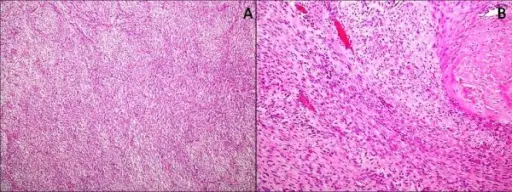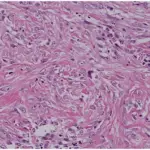Fibromatosis is a rare benign growth of the breast’s stroma made up of spindle-shaped cells that closely resemble normal breast cells.
What is the Pathology of Fibromatosis?
The pathology of Fibromatosis is:
-Etiology: The exact cause of fibromatosis remains unclear.
-Genes involved: Somatic β-catenin, CTNNB1, or APC gene.
-Pathogenesis: The sequence of events that lead to fibromatosis may be driven by a combination of genetic mutations, high estrogen states, and antecedent trauma which leads to activation of the canonical Wnt / β catenin pathway.
-Histology: The histology associated with fibromatosis shows long, sweeping fascicles with thin-walled vessels and microhemorrhages, bland cells with mild to moderate cellularity, and minimal atypia.
How does Fibromatosis Present?
Patients with fibromatosis typically affect females present at the age range of 36-42 years. The symptoms, features, and clinical findings associated with fibromatosis include cafe au lait spots, freckling in the armpits or groin area, lisch nodules, neurofibromas, and optic glioma.
How is Fibromatosis Diagnosed?
Fibromatosis is diagnosed by MRI, CT scan, and biopsy.
How is Fibromatosis Treated?
Fibromatosis is treated by surgical excision with a wide surgical margin.
What is the Prognosis of Fibromatosis?
The prognosis of fibromatosis is poor with local aggression of 20 – 30%.



